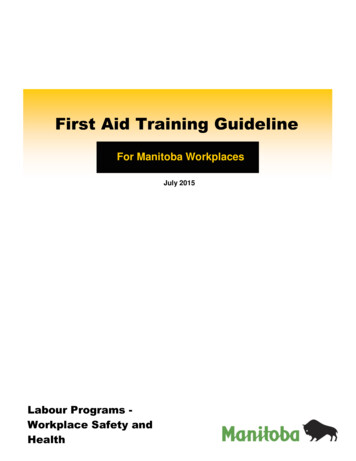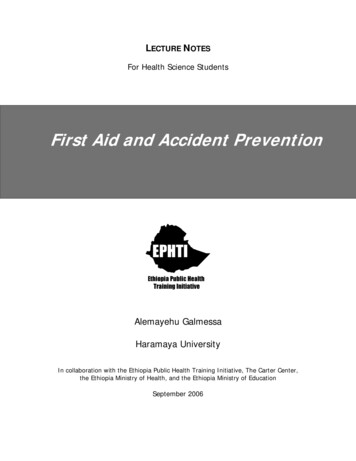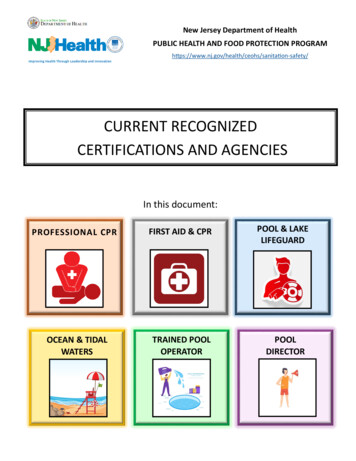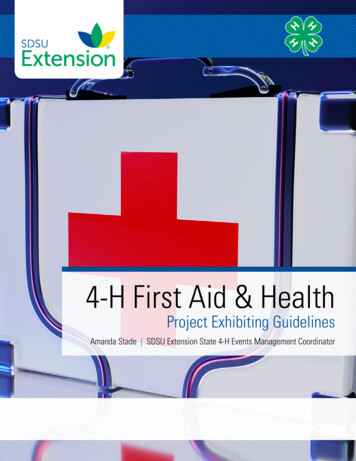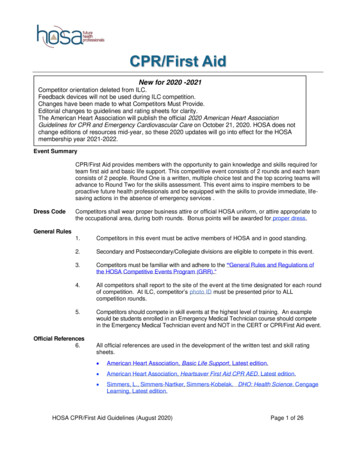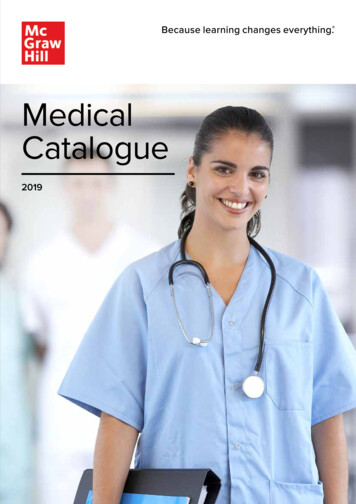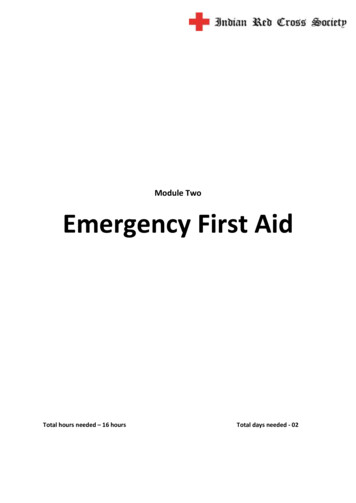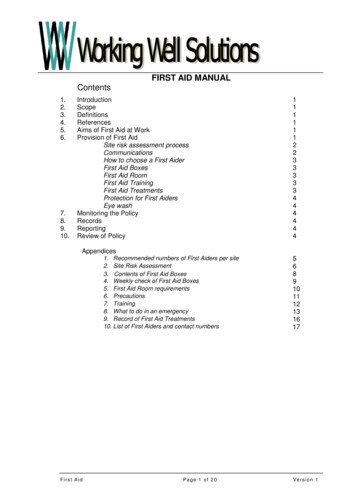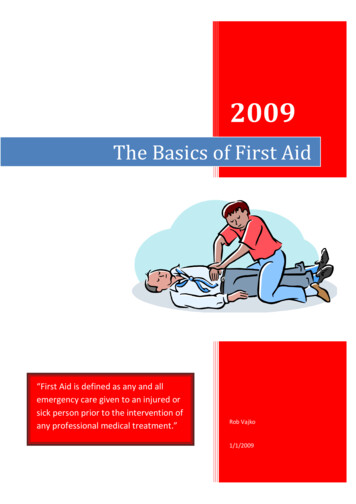
Transcription
Essential First AidMANUAL
New Zealand Red Cross now carriesthe most comprehensive range offirst aid kits in New Zealand.The range offers solutions for home, car, sport, business,kitchen, grab bag and much, much more.For more information go to redcrossshop.org.nzOUR PRODUCTSMotokitBiohazardWorkplaceCateringEye WashGrab and Go0800 233 243redcross.org.nz
F I R S T A I D S Y S T E M SPECTRAF I R S T A I D S Y S T E M DORERSPECTRAWNOSPECTRAF I R S T A I D S Y S T E M F I R S T A I D S Y S T E M !SPECTRAF I R S T A I D S Y S T E M SPECTRAF I R S T A I D S Y S T E M SPECTRAFIRST AID SYSTEMSPECTRAFIRST AID SYSTEMA practical, convenient and innovative new system,designed to effectively equip your workplace withfirst aid, ensuring your legal requirements are met.All workplaces are unique and the first aid requirements are too. Choosing from six individualoptions will let you create the Workplace First Aid System your risk assessment demands.ɠ Workplace blue forfood areasɠ Online portalfor orderingreplacement stockɠ Low, medium and highrisk first aid coursesɠ App and online learningFOR MORE INFORMATION:firstaid@redcross.org.nz
Sending for helpIf you are not sure whether emergency services areneeded, call anyway. They can help you decide.Remain calm. Take a deep breath,call an ambulance. In New Zealand, call 111.Know the emergency numbers for where you areor where you are going.Emergency numbers: Always send for help as soon as possible. Once youhave made contact, LISTEN carefully and answerthe questions.The following information will be required by thedispatcher:ɠɠɠɠWhere the emergency happenedThe telephone number you are calling fromWhat has happenedThe number of people who need helpQuick assessmentIf you are able to quickly assess the casualty, obtain thefollowing information:ɠɠɠɠIs the casualty awake?Can the casualty talk to you?Is the casualty breathing normally?Is the casualty bleeding severely?Tell the dispatcher what you find in your quick assessment.If you feel you are unable to do anything,send for help.
Essential First AidNew Zealand Red Cross helps people in New Zealandand across the Pacific to respond in a crisis and has beenteaching first aid for many years. All the topics coveredin first aid and emergency care courses are containedin this book, which acts as a primary reference.What do you do when?Your father collapses after complaining of indigestion all day.Your daughter gashes her foot on broken glass.You’re first on the scene when a pedestrian is hit by a car.TR35-010-01(2021)One of your team mates sprains an ankle during practice.Your toddler chokes on a piece of apple.
This book contains first aid information and isintended to supplement and revise informationlearned on New Zealand Red Cross First Aid courses.Published by authority of the National Board of NewZealand Red Cross.Published by the New Zealand Red Cross.69 Molesworth Street, Thorndon, Wellington.This book is copyright. Except for the purposeof fair reviewing, no part of this publication maybe reproduced or transmitted in any form or byany means, electronic or mechanical, includingphotocopying, recording, or any information storageand retrieval system, without permission in writingfrom the publisher. Infringers of copyright renderthemselves liable to prosecution.ISBN 978-0-908998-29-6 2021 New Zealand Red Cross.The author asserts its moral rights in the work.First published 1996.Reprinted annually with new information as required.Printed 2021.Written and designed by New Zealand Red Cross.Photographs and illustrations courtesy of American,Australian, New Zealand, Samoa, Tuvalu and PapuaNew Guinea Red Cross, IFRC Pacific Delegation, NewZealand Resuscitation Council and National HeartFoundation of Australia. Additional photography:Richard Bartz, Munich aka Makro Freak, CC BY-SA 2.5,via Wikimedia Commons; Cugerbrant, CC BY-SA 4.0,via Wikimedia Commons.All rights reserved in all countries.
ContentsChokingAdult23-3124What is first aid?1First aider1Conscious – Back blows /Chest thrusts / Obstructed airwayFirst aid aims2Unconscious – Obstructed airway272–3DRSABCD – Choking adult / child28First aid action planWhen to call an ambulance3Primary assessment4Using DRSABCD52,6DangersResponse – Levels of consciousness(AVPU)7Airway8BreathingBreathing difficulties8,12–159Circulation / CPR9Unconsciousness10Stable Side Position(recovery position)DRSABCD – ResuscitationBasic Life Support FlowchartResuscitation1112–141415-22Chain of survival15Resuscitation – Adult16CPR action checklist16DRSABCD – Adult resuscitation17Defibrillation and AEDs18Resuscitation – Child / Infant19Infant – Conscious29–30Infant – Unconscious31DRSABCD – Choking infant31Bleeding32External bleeding32–33Wounds32–33Embedded objects in wounds34Internal bleeding35DRSABCD – Bleeding35Shock and fainting36–37Check for otherconditions and injuries 38–41Vital signs38–39Consciousness (AVPU)40Check for injuries / MedicAlert 41Medical conditionsHeart attack42–5742–44Angina43Heart health44CPR action checklist20Heart attack action planDRSABCD – Child / infantresuscitation21Diabetic emergency22Seizures / Febrile convulsionsDrowning24–26Stroke4546–474849–50
HyperventilationAsthma5151-52DRSABCD – Medical ��75Fractures58–59Poisoning80–85Snake bites82Fish and shellfish poisoning82DRSABCD – Poisoning84Tick bites; bee, wasp and ant stings85Severe Anaphylaxis action plan87Soft tissue injuries / bruising61DRSABCD – Severe allergic reaction87DRSABCD – Fractures andsoft tissue injuries62Spinal injuries63EnvironmentalconditionsDRSABCD – Spinal injuries64Head injuries65–67Concussion65Brain compression66DRSABCD – Head injuries67Fractured nose67Stable Side Position for heador spinal injuries – Log roll68Amputations69Chest injuriesHyperthermia88–9288-90Heat exhaustion88Heat stroke89DRSABCD – HyperthermiaHypothermiaDRSABCD – Hypothermia9091-929270Other usefulinformation93–102Abdominal injuries70Casualty reporting93Crush injuries71Handwashing and hygiene93Nose bleeds72Applying slings94Ear injuries72Hazard appKnocked out permanent teeth73Household Emergency PlanEye injuriesBurns and scaldsDRSABCD – Burns and scalds74-7576–7979Useful numbers9697–9899Workplace accidents100Suicide information101Psychological First Aid102GlossaryIndexMission statement103–104105-106
First aid is the initial helpprovided to the ill or injuredperson until advanced carearrives.WHAT IS FIRST AID?What isfirst aid?It is concerned not only withphysical injury or illness but alsowith other initial care, includingpsychosocial support for peoplesuffering from emotional distresscaused by experiencing orwitnessing a traumatic event. Firstaid interventions seek to “preservelife, alleviate suffering, preventfurther illness or injury and promoterecovery”.1This manual refers to the personrequiring care as a casualty. Theresponder, with their basic first aidknowledge and skills, provides theassistance and is referred to as thefirst aider.Further emergency careinformation for Basic LifeSupport and First Aid canbe found in the Guidelinesdocuments found on theNew Zealand ResuscitationCouncil website nzrc.org.nz.New Zealand Red Crossacknowledges the NewZealand Resuscitation CouncilGuidelines.1 International Liaison Committee on Resuscitation (ILCOR), 20151
FIRST AID AIMS ACTION PLANFirst aidaimsFirst aidaction planIn emergency situations,injuries or medicalconditions can kill:In first aid the DRSABCD cycleis used to assist the first aider toidentify, prioritise and treat anyproblems.ɠ in minutesɠ within hours, orɠ not at all.General principlesɠ Ensuring safety of the firstaider, casualty and bystandersɠ Preventing further harmor injuryɠ Checking response to verbaland tactile stimuliɠ Sending for helpɠ Care of airway, breathing,circulationɠ Control of bleedingɠ Protection fromenvironmental conditionsɠ Other specific first aid carerelevant to the circumstancesɠ Careful handlingɠ Reassuranceɠ Ongoing monitoringWhat is DRSABCD?DRSABCD is an abbreviation for the casualtyprimary assessment process used by theNew Zealand Red Cross and stands for:Dangers, Response, Send for help, Airway,Breathing, Circulation / CPR, DefibrillationMany countries use the DRSABCD casualtyassessment process at all levels of care.DRSABCD identifies the Dangers to thefirst aider, casualty and bystanders as thefirst issue to address. The first aider thenchecks for a Response from the casualtyand considers Sending for help at thisearly stage of the assessment. Simpleand logical steps are used to ensure anopen Airway, and to assess and manageBreathing and Circulation (bleeding andshock). If the casualty is unresponsive andnot breathing, the first aider starts CPRimmediately and attaches a defibrillator(Automated External Defibrillator) assoon as possible.The purpose of DRSABCD is to assistrescuers to identify injuries or medicalconditions and treat the casualty untilthe ambulance or advanced care arrives.DRSABCD is used as the guide for first aidgiven to casualties in all situations.Repeat the DRSABCD cycle as neededuntil advanced care arrives.2
The first aid action planinvolves:ɠ primary assessment (DRSABCD);ɠ specific care – identification andmanagement of specific injuriesand medical conditions using themethods outlined in this manual;ɠ general care – keeping the casualtywarm and comfortable, ongoingmonitoring, rest and reassurance.Staying with them until advancedcare arrives; and,ɠ handover of the casualty to thenext level of care.For life threatening illnessor injury – call an ambulanceimmediately.Send for help – call an ambulance ifthe casualty has:ɠɠɠɠɠɠɠɠɠɠcollapsed or is unresponsive.absence or difficulty breathing.chest pain.severe bleeding.signs of stroke (e.g. face droop,arm weakness, speech changes).signs of shock (e.g. anxious, pale,cold, sweaty, feeling sick or faint).severe allergic reaction (e.g.facial swelling, wheezing, nausea,vomiting).repeated or first time seizures.severe fractures and burns.MedicAlert conditions.ACTION PLAN WHEN TO CALL 111When to callan ambulanceIf in doubt, find out; alwayscall an ambulance immediatelyif unsure.The ambulance staff will advise theright care, in the right place, at theright time.For more advice and information, callHealthline 0800 611 116 (NZ) or amedical centre.3
PRIMARY ASSESSMENT – DRSABCDDRSABCDFollowing the simple DRSABCD process below, the first aider makesa primary assessment to identify any immediately life-threateningconditions. The findings will indicate any action to be taken.Repeat the DRSABCD sequence until advanced care arrives.OBSERVE/CHECKACTIONCheck for hazards and risks.Check scene safety for:ɠ yourselfɠ the casualtyɠ bystandersIf possible, eliminate, isolateor minimise hazards and risks.Only move the casualty ifthere is a clear reason todo so.DDANGERSRCheck for response.RESPONSE(Alert Voice PainUnresponsive)Shout and tap.SSEND FOR HELPSend for help.Call an ambulanceimmediately if no response.Consider AED.AAIRWAYConsider airwayobstruction.If no response open airway(Head tilt/Chin lift).BBREATHINGIf unresponsive and notbreathing normally.Start CPR.If unresponsive andbreathing normally.Position the casualty on theirside.If not breathing normally.Start CPR.If bleeding.Use direct pressure tocontrol bleeding.If showing signs of shock.Treat shock.CDCIRCULATION/CPRDEFIBRILLATIONAttach AED ASAP if needed(if the casualty is notbreathing normally).GENERAL CARE When/if breathing normally, position the casualty on theirside. Monitor and reassure the casualty.4
A practical exampleBelow is a practical example of how first aiders can use DRSABCD.You are walking through the park when you see an elderly man stumble and fall.When you go to help you notice he is trying to get up and has blood comingfrom a wound on his hand. You decide to act.DANGERSCheck for dangers. Ensure safety for self, casualty andbystanders.You check the scene for obvious hazards and risks and notethe presence of blood. You put on gloves.RESPONSE(AVPU)(See AVPU, p7)You ask him if he is OK.He speaks to you. He is alert.You introduce yourself and ask if you can help him.SEND FOR HELPSend or shout for help.You ask bystander for help. Consider AED.AIRWAYThe casualty talks easily and has no obvious airway problem.BREATHINGYou ask if he is OK. Breathing is rapid.USING DRSABCDUsing DRSABCDCIRCULATION/CPR Casualty appears pale and says he feels light headed.You send bystander to call for an ambulance immediately,because of the signs of shock.DEFIBRILLATIONConsider AED.– If needed, attach and follow prompts.SPECIFIC CAREYou lie the casualty in the shock position.You treat the hand wound.You check that the ambulance is on the way.You ask if the casualty has a history of heart-relatedproblems, they say yes.You check for other injuries and cannot find any.GENERAL CAREYou keep the casualty warm and reassure him.You stay until the ambulance arrives.5
DANGERSDangersEnsure scene safetyMovement from dangersMovement can worsen the casualty’scondition by increasing pain, injury,blood loss or shock. Only move acasualty if there is a clear reason todo so (to ensure safety; in extremeweather or on difficult terrain wheremovement is essential; to makepossible the care of ABCs (Airway,Breathing, Circulation), perform CPRor control of severe bleeding).HOW TO HELP The one person dragStay with the casualty and sendothers to get help.The one-person drag is the bestway for the lone rescuer tomove the casualty from danger.A blanket may also be used.6
Levels of consciousnessThe casualty’s response is a measure of their Level of Consciousness. An initialcheck of consciousness is performed in the Primary Assessment using the Shoutand Tap method. More detailed assessment of a casualty’s level of consciousnessshould be made as part of the Secondary Assessment.RESPONSEResponseThe check should be repeated at regular intervals and medical personnel should beadvised of any patterns. Patterns may show changes in the casualty’s condition.LEVELS OFCONSCIOUSNESSAALERT andresponsiveRESPONSETalks and responds to questionsappropriately. For example:ɠ What time of the day is it?ɠ What sport were you playing?ɠ What town are you in?Talks, but may be anxious, irritable orconfused.May repeat questions several times,forgetting that answers have beenprovided.May start to become drowsy.VConsidercalling anambulanceDrowsy butObeys instructions such as,responds to VOICE ɠ move your armsɠ open your eyesor responds to instructions by grunting,groaning, moving the head or similarattempts to acknowledge.Considercalling anambulancePUnconscious, doesnot respond tovoice but respondsto PAINDoes not speak or respond toinstructions. Moves away from painfulstimuli. Moves head away or grimaceswhen tapped on the shoulder.Considercalling anambulanceUUNRESPONSIVEUnconsciousDoes not speak. Does not respond inany way to pain or voice.Send or shoutfor help – callan ambulanceimmediately7
AIRWAY BREATHINGAirwayBreathingIf a casualty is unconsciousthey will be unable tomaintain an open airway toallow air to enter the lungs.Opening the airway of anon-breathing unconsciouscasualty may be the only steprequired to save their life.When we breathe, the bodyuses only part of the oxygenwe breathe in, so there is stilloxygen in the air when webreathe out. This is why thefirst aider’s breath can beused to provide a casualty’soxygen needs.Open their airway using Head tilt/Chin lift as follows:Look, listen and feel for breathing forup to 10 seconds.HOW TO HELP Head tilt/Chin liftIf a casualty is breathing normally,position the casualty on their side.See Stable Side Position, p11.The normal adult breathing rate is12-20 breaths per minute (about 2-3breaths in 10 seconds). Children andinfants breathe at a faster rate.Place one hand on the foreheadand two fingers of the other handon the bony part of the chin. Tiltthe head back using the hand onthe forehead, and at the sametime lift the jaw upwards withthe fingers of the other hand.8
SIGNS AND SYMPTOMS OF BREATHING DIFFICULTIES:ɠ difficulty breathingɠ difficulty speakingɠ anxietyɠ inappropriate or lack of speechɠ noisy breathing, wheezing,coughingHOW TO HELP MANAGE BREATHINGDIFFICULTIES:ɠ Call an ambulance immediately.ɠ Monitor ABCs.ɠ Make as comfortable as possible.ɠ Encourage casualty to take theirmedication.ɠ Rest and reassure casualty.ɠ If the casualty is unresponsiveposition them on their side.Circulation /CardiopulmonaryResuscitation (CPR)The heart beats to pumpblood around the body.Breathing is a sign ofcirculation. If there isno circulation, normalbody activity will cease.Commence CPR.Unresponsive and notbreathing normally CPR attach AED ASAP.BREATHING DIFFICULTIES CIRCULATION/CPRBreathingdifficultiesUnresponsive and breathingnormally stable sideposition.In both situations send forhelp immediately.Major bleeding must be managedearly to prevent shock developingas the blood volume lowers.Use direct pressure to controlbleeding.See Bleeding and Wounds, pp32–35.Minimise shock by laying the casualtydown, keeping them warm andreassuring them.Pale, cold sweaty skin, a weak rapidpulse, and rapid breathing indicateshock.See Shock, p36.9
UNCONSCIOUSNESSUnconsciousnessUnconsciousness may occurfor a number of reasons.Head injury, low bloodsugar in diabetes, seizuresand strokes can all result inunconsciousness. You do notneed to know the cause totreat unconsciousness.Before the loss of consciousnessthe person may experience yawning,dizziness, sweating, have changes inskin colour, blurred vision or nausea.HOW TO HELP MANAGE UNCONSCIOUSNESS:ɠ Obtain help. Send someone tocall an ambulance immediately.ɠ Position the casualty in theStable Side Position.ɠ Check for any injury or illnessduring the secondary assessment.ɠ Quickly stop any bleeding.ɠ DO NOT give the casualty anyfood or drink.ɠ Stay with the person.The major danger to anunconscious casualty is airwayobstruction from the tongue.Position the casualty ontheir side.10Identify and assessunconsciousnessThere are levels of unconsciousness.A deeply unconscious casualty willnot be able to speak or respondto what you say. The Level ofConsciousness: AVPU chart on page7 provides methods to check levels ofconsciousness.Initially you will have identifiedunconsciousness while checkingfor response during the primaryassessment using the Shout andtap method.All unresponsive/unconsciouscasualties should be positioned ontheir side, ensuring that the airway isopen. Monitor breathing.DO NOT leave the person sitting in achair or put their head between theirknees.Any person who fails to respondor shows only a minor response tosimple commands such as “openyour eyes; squeeze my hand; let it go”should be managed as if unconscious.
(Recovery position)The Stable Side Position (aside-lying recovery position)is designed for unconscious,breathing casualties. It helpsto maintain an open airwayand allows vomit and otherfluid to drain freely fromthe mouth.If a casualty is unresponsive (doesnot respond to your “shout andtap”, for example talk and touchcommands such as “open youreyes” or “squeeze my hand”),groans without opening their eyes,or does not react to you graspingand squeezing their shoulders firmlyto elicit a response, then gentlyposition the casualty in the StableSide Position (recovery position)while being careful to avoid anytwisting or forward movement of thehead and spine.The Stable Side Position issometimes referred to as therecovery or lateral position.The Stable Side Position(recovery position)STABLE SIDE POSITIONStable Side PositionWhere you suspect neckor spinal injuries in anunconscious casualty, logroll them onto their side,supporting their head andkeeping the spine in line.See Log Roll, p68.An unconscious, breathingcasualty who is obviouslypregnant should be placedon their left side.11
DRSABCD – RESUSCITATIONDRSABCDUnresponsive and not breathing normally CPRDRSABCDContinue CPR until normal breathing returns.Check for DANGERSCheck for RESPONSE (Shout and Tap)SEND for help (Dial 111 – Consider AED)Open the AIRWAY (Head tilt/Chin lift)Check for BREATHING ( Look, listen and feel for breathing for 10 seconds)CIRCULATION/CPR/DEFIBRILLATION (AED)Attach Automated External Defibrillator (AED) as soon as possible.NoYes(Breathing abnormalor absent)Child (under 8 years) Infant (0-1 year)Adult (over 8 years)Start CPR* (30:2)Go for help if aloneIf alone, go for helpafter one minute ofCPRStart CPR* (30:2)DefibrillationAttach AED as soon asDefibrillationAttach AED as soon aspossible and follow voicepromptspossible and follow voicepromptsContinue CPR untilContinue CPR untilresponsiveness ornormal breathing returns12(Breathing present)responsiveness ornormal breathing returnsPosition the casualtyin the Stable SidePositionIf not fully responsive orunconsciousMonitor ABCsStop bleeding.Treat shock.Look for other injuriesor casualties* See chart opposite
DRSABCD – RESUSCITATIONResuscitationOpen Airway. Check for Breathing. Start CPR.If available, attach AED. Follow voice prompts.AdultChildInfantCompressions.Push hard.CompressionsCompressionsTwo hands, centreof chest.One hand, centreof chest.Two fingers, justbelow nipple lineCompressions tobreaths30:230:230:2Compressionsper minute100-120100-120100-120(over 8 years)Start withCompressions1/3 depth of chest(1-8 years)(0-1 years)For all your first aid training needs in New Zealand0800 RED CROSS (0800 733 276)redcross.org.nz13
BASIC LIFE SUPPORT FLOWCHART14Basic Life Support Flowchart
Chainof survivalThe aim of CPR is to provideoxygen to the brain and heartuntil appropriate advancedcardiac life support canrestore normal heart beatand breathing.Most sudden cardiac arrestsoccur outside of hospitalwith death occurring withinminutes of onset.Most adults require CPR as a resultof a heart problem so an emphasisis placed on calling the ambulance,early CPR and attaching an AED assoon as possible.For the purpose of resuscitation anadult is anyone over eight years of age.Resuscitation should be startedwhere the person is unresponsiveand not breathing normally.For more information visit theNew Zealand ResuscitationCouncil website nzrc.org.nzThe chain of survival lists thepriorities and actions to be followedto give the casualty the best chanceof surviving sudden cardiac arrest.RESUSCITATION CHAIN OF ly accessHOW TO HELP TO GREATLY IMPROVETHE CHANCE OF SURVIVAL:ɠ Get access to advanced careas early as possible (callfor help; call an ambulanceimmediately).ɠ Start CPR fast.ɠ Use an AED (defibrillator) assoon as possible.ɠ Continue CPR until advancedcare help arrives.Early CPREarlydefibrillationEarly advancedcare15
RESUSCITATION – ADULTResuscitationAdult – CPR action checklistHOW TO HELP 1 Check for dangers and hazards. Consider safety.2 Response: Shout and tap the casualty to see ifthey respond.3 Send for HELP. Call an ambulance immediately.4 Airway openɠ Open the airway using Head tilt/Chin lift.5 Breathing: Check for normal breathing.Look, listen and feel for breathing – airflow atthe mouth and nose (check for no more than10 seconds).ɠ If not breathing normally, start CPR.ɠ If breathing and unconscious.– Position the casualty in the Stable Side Position.– Monitor for breathing, treat for shock.– Go for help if alone.6 Circulation / CPR – Start CPRɠ Position casualty laying on their back on a hard,flat surface.ɠ Compressions – give 30 compressions.ɠ Rate of compressions: 100–120 per minute.ɠ Hands on centre of chest (use heels of hands).ɠ Depth: 1/3 depth of chest (5cms or more onan adult / 5cms for a child / 4cms for an infant).Smooth up and down pressure.ɠ Minimise pauses.Open airwayHead Tilt Chin LiftLook, listen and feelfor breathing (no morethan 10 seconds)CPR ratio 30:230 compressions:2 rescue breaths7 Give two effective rescue breaths, over onesecond each.ɠ An effective breath is completed when thechest begins to rise.8 Continue CPR at a ratio of 30:2Give 30 compressions to two breaths until helparrives or the casualty begins to breathe.9 Defibrillation – Get and attach AED as soon aspossible and follow voice prompts. Use AED assoon as possible for all ages.16Attach AED assoon as possiblePhotos courtesy Tracey Kearns
Adult – DRSABCDCPR (i.e. chestcompressions andrescue breathing)is provided forcirculation.HOW TO HELP DDANGERSCheck for hazards and risks.Ensure safety for self, casualty and bystanders.RRESPONSE (AVPU)Shout and tap, if unresponsive.SSEND FOR HELPSend or shout for help. Send bystander to callan ambulance immediately. Consider AED.AAIRWAYOpen airway by using Head tilt/Chin lift.BBREATHINGLook, listen and feel for breathing forup to 10 seconds.If not breathing normally START CPR.If ALONE, go for help before starting CPR.CCIRCULATION/CPRCommence CPR:30 compressions / two rescue breaths.Depth: compressions at least 1/3 of the chestdepth using two hands centre of chest.Rate: 100-120 per minute.Each rescue breath delivered over one second.DDEFIBRILLATIONIf NOT BREATHING NORMALLY, continue withCPR. Attach AED as soon as possible and followvoice prompts.RESUSCITATION – DRSABCD – ADULTResuscitation17
DEFIBRILLATION AND AEDSDefibrillation and AEDsA defibrillator is an electronicdevice that sends anelectrical shock through thecasualty’s chest in an attemptto restore a normal heartrhythm. Early defibrillationsignificantly improves thechance of survival.Defibrillators located in places likeshopping malls, supermarkets andother public facilities are usually anautomatic, easy to use, voice-guideddevice and are therefore called anAutomated External Defibrillator(AED). These can be used by membersof the public, even without training.If paediatricspecific pads areavailable they canbe used on children under the age ofeight years. If they are not availableuse standard adult pads ensuring thepads do not touch each other. Forsmaller children, place one pad onthe centre of the chest and the otherpad on the upper back between theshoulder blades.Pad location isshown on the AED.For all unresponsive casualties whoare not breathing, start CPR andattach an AED as soon as one isavailable.The AED checks the casualty’sheart rhythm, decides if a shock isneeded and provides step-by-stepinstructions. Simply turn on the deviceand follow the voice instructions onhow to perform each step that isrequired.You cannot accidentally shock thecasualty as the AED decides on, anddelivers, the shock process. It will notshock someone who does not needa shock.18Modern AEDs are easy to useand can be purchased throughNew Zealand Red Cross.redcrossshop.org.nz/aed
Child (and infants under one year old)For the purposes ofresuscitation a child isconsidered to be aged eightyears and below.Unlike adults, children are rarelyaffected by cardiac arrest due toheart attack. Most non-breathingchildren are the result of airway andbreathing problems.RESUSCITATION – CHILD / INFANTResuscitationWhen you are alone and the childor infant is not breathing, performCPR for one minute then call anambulance immediately.CALL FASTWhen you are alone and thechild or infant is not breathing,perform CPR for one minutethen call an ambulanceimmediately.19
RESUSCITATION – CHILD / INFANTResuscitationChild under eight years old (includes infant)CPR action checklistHOW TO HELP 1 Check for dangers and hazards. Consider safety.2 Check for response. Shout and tap, pick infant up.3 Send for help – ask bystanders to call an ambulanceimmediately.IF ALONE, stay with the child or infant. Consider AED.4 Airway openInfant (under oneyear old)Open airway. Move headinto neutral positionɠ Child – Head tilt/Chin liftɠ Infant – Move head into neutral position andsupport lower jaw as pictured.For how to resuscitate an adult, see p16.5 Check for normal breathing.Look, listen and feel for breathing (no more than10 seconds).ɠ IF NOT BREATHING NORMALLY, start CPR.ɠ IF ALONE, go for help after one minute of CPR.Look, listen and feelfor breathing (nomore than 10 seconds)6 Circulation / CPR – start CPRɠ 30 compressions.ɠ Rate of compressions: 100-120 per minute.ɠ Apply smooth up and down pressure.ɠ Child 1–8 years old – Position one hand on the centreof the chest. Depth of compressions should be 1/3 ofthe chest depth.ɠ Infant under one year old – Two fingers just below thenipple line. Depth of compressions should be 1/3 ofthe chest depth.CPR RATIO 30:230 compressions:Two rescue breaths7 Give two effective rescue breaths (an effectivebreath is completed when the chest begins to rise).Each rescue breath delivered over one second.8 Continue CPR at a ratio of 30:2IF ALONE, go for help after one minute of CPR. Give30 compressions to two breaths until there is either aresponse from the child or until help arrives.9 If child begins to breathe, position on their side andmonitor breathing.20Photos courtesy Tracey KearnsAttach AED as soon aspossible (use paediatricpads if available)
Child under eight years old (includes infant)DRSABCDHOW TO HELP DDANGERSCheck for hazards and risks. Ensure safety for self, casualty and bystanders.RRESPONSE (AVPU)If casualty is unresponsive.SSEND FOR HELPSend or shout for help. Send bystander to call an ambulanceimmediately. IF ALONE, stay with the child. Consider AED.AAIRWAYChild (1–8 years old) – Open airway by Head tilt/Chin lift.Infant – Open airway by moving head into neutral position.BBREATHINGLook, listen and feel for breathing for 10 seconds.IF NOT BREATHING normally; START CPR.IF ALONE, go for help after one minute of CPR.CCIRCULATION/CPRContinue CPR – 30 compressions : two rescue breaths (30:2).Rate of compressions: 100–120 per minute.Child compressions – 1/3 of the chest depth.Infant compressions – 1/3 of the chest depth.Each rescue breath should be delivered over one second.IF ALONE, go for help after one minute of CPR.DDEFIBRILLATIONAttach AED as soon as possible and follow voice prompts.For smaller children, place pad on the
Written and designed by New Zealand Red Cross. Photographs and illustrations courtesy of American, Australian, New Zealand, Samoa, Tuvalu and Papua New Guinea Red Cross, IFRC Pacific Delegation, New Zealand Resuscitation Council and National Heart Foundation of Australia. Additional photogra
